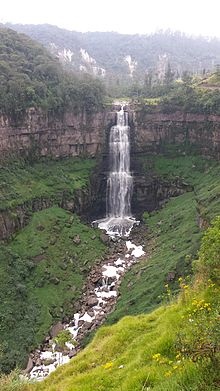|
Tequendama Falls
The Tequendama Falls (Spanish: Salto del Tequendama) is a 132 metres (433 ft) high waterfall of the Bogotá River, located 32 kilometres (20 mi) southwest of Bogotá in the municipality of Soacha. Named after the adjacent settlement of Tequendama, it holds historical significance as one of Colombia's earliest permanent settlements.[1] The falls were painted in 1854 by Frederic Edwin Church.[2] One of the country's tourist attractions, the falls are located in a forested area 32 kilometres (20 mi) west of Bogotá. The river surges through a rocky gorge that narrows to about 18 metres (59 ft) at the brink of the 132 metres (433 ft) high falls. During the month of December the falls become completely dry. The falls, once a common site for suicides,[3] may be reached by road from Bogotá. Muisca originIn Chibcha, the nameTequendama translates to: "he who precipitated downward".[4] According to the Muisca religion, the waterfall was created by the legendary hero Bochica, who used his staff to break the rock and release the water that covered the Bogotá savanna.[5] According to another legend, during the Spanish conquest and evangelization of the Americas, in order to escape the new colonial order indigenous people of the area would jump off the Salto Del Tequendama and become eagles to fly to their freedom. Recovery of the Falls and its surroundings
The river that feeds the falls is currently considered to be one of the most contaminated in the world.[6]
A historic hotel building, now a museum that overlooks the waterfall is undergoing restoration aided by the French government.[7] See also
References
Bibliography
External linksWikimedia Commons has media related to Salto del Tequendama.
|
||||||||||||||||||||||||



